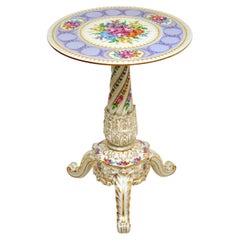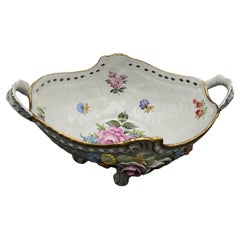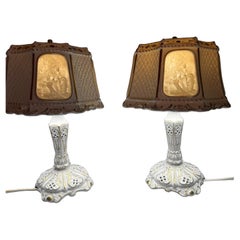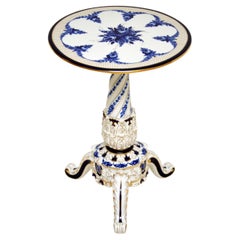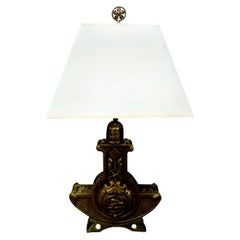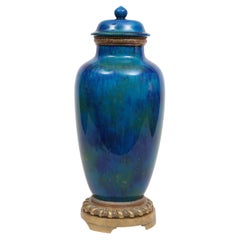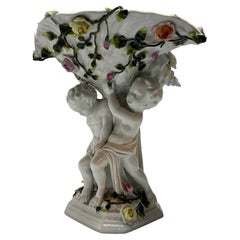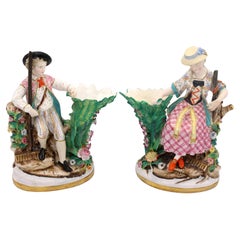Von Schierholz Porcelain Furniture
to
4
4
1
4
2
2
1
1
1
4
4
4
4
4
4
4
2
9,730
3,930
2,547
2,240
Creator: Von Schierholz Porcelain
Antique Dresden Style Porcelain Side Table
By Von Schierholz Porcelain
Located in London, GB
A stunning antique Dresden style porcelain occasional table. This was made in Germany by Von Schierholz, it dates from around the 1950’s.
The quality is outstanding, this is beautif...
Category
1950s German Vintage Von Schierholz Porcelain Furniture
Materials
Porcelain
Rococo style Jardinière with hand-painted floral pattern from PMP Germany
By Von Schierholz Porcelain
Located in Skien, NO
Richly decorated Rococo style high quality German porcelain Jardinière with hand-painted floral pattern from PMP 1817 GDR Germany.
Handpainted porcelain, artist signed under. Gold ...
Category
Late 20th Century German Rococo Von Schierholz Porcelain Furniture
Materials
Porcelain
Art Nouveau While Lithophane Porcelain Two Lamps Schierholz PMP 1970
By Von Schierholz Porcelain
Located in Uppsala , SE
2 Elegant Lithophane Porcelain lamps, Schierholz, PMP, Plaue, late 20th century,
A lithophane is a thin plaque of translucent material, normally porcelain, which has been moulded to ...
Category
1970s German Vintage Von Schierholz Porcelain Furniture
Materials
Porcelain
Antique Dresden Style Porcelain Occasional Table
By Von Schierholz Porcelain
Located in London, GB
A stunning antique Dresden style porcelain occasional table. This was made in Germany by Von Schierholz, it dates from around the 1960’s.
The quality is outstanding, this is beautif...
Category
1960s German Vintage Von Schierholz Porcelain Furniture
Materials
Porcelain
Related Items
Austrian Art Nouveau Bronze Lamp
Located in Houston, TX
Lovely period Austrian Art Nouveau bronze table lamp. This beautifully detailed, high quality Austrian bronze lamp has been newly wired and would w...
Category
1910s Austrian Art Nouveau Vintage Von Schierholz Porcelain Furniture
Materials
Bronze
Porcelain amphora PMP by SEVRES
Located in Ciudad Autónoma Buenos Aires, C
Porcelain amphora in shades of blue and green with bronze. Signed M P, SEVRES, CH
France, CIRCA 1920.
Category
1920s French Art Deco Vintage Von Schierholz Porcelain Furniture
Materials
Porcelain
19th Century Hand Painted Faience Jardiniere on Pedestal from Boulogne, France
Located in Dallas, TX
This fantastic faience jardiniere and pedestal were hand-painted in Boulogne, France (formally “Boulogne-sur-Mer”) in the late 1800’s. The vibrant set features heraldic displays set among foliate and floral illustrations. Both the pedestal and the jardiniere have white backgrounds festooned with green leaves and blue, yellow, orange, and purple flowers.
The opening of the jardiniere has asymmetrical edges dotted by small piercings, with flowering vines painted along the inner rim. Exquisite handles, comprised of curled leaves and C-scrolls, are affixed to the sides of the lobed body. Numerous painted motifs grace the area between the handles, including drapery, scrolls, and floral baskets hanging from an arabesque border.
Equally impressive décor can be seen on the tetrapartite stand with a molded top. Each layer of the molding has a different color scheme, ranging from yellow with volute embellishments to solid green. The neck of the stand has been adorned with floral displays above multi-colored scrolls, shells, and scalloped leaves. In the center of each scalloped leaf is a distinct heraldic shield: on one side is a French style shield representing the city of Boulogne, with a swan that symbolizes perfection. On the opposite side is coat of arms topped by a closed crown, emblazoned with a five-fold cross over three roundels, which is the coat of arms for Godfrey of Bouillon, the first ruler of Jerusalem, who was born in Boulogne. Beneath the coat of arms are a pair of scrolled feet adorned with scalloped leaves and scrolls. There are two more feet to the sides that have pierced elements with floral vines beneath.
Our 19th century hand-painted faience jardiniere on pedestal...
Category
19th Century French Antique Von Schierholz Porcelain Furniture
Materials
Faience
$4,300
H 44.625 in W 21.5 in D 15 in
Mid-19th Century French Hand Painted Faience Jardinière from Rouen
By Rouen
Located in Dallas, TX
Decorate a dining room table or a mantel with this large antique jardinière; crafted in Normandy, circa 1860, the oblong planter stands on scrolled feet...
Category
Mid-19th Century French Louis XV Antique Von Schierholz Porcelain Furniture
Materials
Ceramic, Faience
Large Antique Moroccan Arabesque Style Octagonal Inlaid Table
Located in Houston, TX
Large antique Moroccan Arabesque style octagonal inlaid table.
This stunning Moroccan octagon shaped table is inlaid with various woods, bone a...
Category
1920s Moroccan Islamic Vintage Von Schierholz Porcelain Furniture
Materials
Bone, Mother-of-Pearl, Wood
19th Century French Painted Ceramic Barbotine Jardinière with Floral Decor
Located in Dallas, TX
This elegant colorful hand painted Majolica planter was sculpted in Montigny sur Loing, France, circa 1860. The ceramic jardinière with root shape handles features high relief soft pink, blue and beige rose flowers with pale green leaves, and brown and grey background. The ceramic vase is in good condition commensurate with age and use (minor chips on few petals).
Impressionist ceramics term generally applies to "paint the slip" or "batch gouache". At the turn of the nineteenth and twentieth centuries, the towns of Montigny-sur-Loing and Marlotte are many artists living places like Jean-Baptiste Corot, Eugène Thirion (1839-1910), Adrien Schulz (1851-1931), Numa Gillet (1868-1940) and Lucien Cahen-Michel (1888-1980), all attracted by the quality of the landscape and the light. When Eugene Schopin founded in 1872 a ceramics factory, he worked with the painters to create a range of designs inspired by Impressionism and decorated according to new public demands. Several ceramic factories will develop around this Impressionist movement. The most famous, such as Georges Delvaux (1834-1909), Albert Boué (1862-1918) and Charles Alphonse Petit (1862-1927), will produce until 1922. Other manufacturers, such as Theodore Lefront...
Category
Late 19th Century French Antique Von Schierholz Porcelain Furniture
Materials
Ceramic, Majolica
$900
H 7.5 in W 12.5 in D 10 in
Majorelle Art Nouveau Lamp
By Atelier Majorelle
Located in NANTES, FR
Majorelle Art Nouveau lamp
Large lamp around 1900 foot in gilded bronze and lampshade in alabaster.
Very good quality of bronze and pretty floral m...
Category
Early 20th Century French Art Nouveau Von Schierholz Porcelain Furniture
Materials
Alabaster, Bronze
Andrianna Shamaris Mid Century Style Teak Wood Side Table
By Andrianna Shamaris
Located in New York, NY
Single slab reclaimed teak wood side table with a natural oil finish revealing the beautiful grain in the wood. Floating on mid century style legs.
Own an Andrianna Shamaris origi...
Category
2010s Mid-Century Modern Von Schierholz Porcelain Furniture
Materials
Wood, Teak, Reclaimed Wood
Daum Nancy Art Nouveau Lamp
By Daum
Located in NANTES, FR
Daum Nancy Art Nouveau table lamp, circa 1910.
High-quality wrought iron base, stamped (illegible).
Powder tulip signed Daum Nancy.
Electric and in perfect condition.
Height: 40.5 c...
Category
1910s French Art Nouveau Vintage Von Schierholz Porcelain Furniture
Materials
Wrought Iron
Art Nouveau lamp circa 1910
Located in NANTES, FR
Beautiful Art Nouveau lamp, circa 1910.
Brown-veined alabaster shell.
The base is bronze with floral decoration.
Electric and in perfect condition.
Total Height: 52 cm
Shell Diamete...
Category
1910s French Art Nouveau Vintage Von Schierholz Porcelain Furniture
Materials
Alabaster, Bronze
Art Nouveau Desk Lamp
Located in NANTES, FR
Desk lamp in gilded spelter circa 1910. Tulip tilt adjustment possible.
Tulip in opalescent glass.
Electrified, B22 socket.
in perfect condition.
Height: 34 cm
Width: 25 cm
Depth: 1...
Category
Early 20th Century French Art Nouveau Von Schierholz Porcelain Furniture
Materials
Spelter
Vintage Art Nouveau Style Pink Flower Painted Porcelain Table Lamp by Wildwood
By Wildwood Lamp Company
Located in Philadelphia, PA
Vintage Art Nouveau Style Pink Flower Painted Porcelain Table Lamp by Wildwood. Circa Late 20th Century. Measurements: 26" H (to finial) x 19" H (to light socket) x 8" W x 8" D. {3-W...
Category
Late 20th Century Unknown Art Nouveau Von Schierholz Porcelain Furniture
Materials
Brass
$325
H 26 in W 8 in D 8 in
Previously Available Items
Rococo Antique Germany Plau Schierholz Porcelain figurine central piece
By Von Schierholz Porcelain
Located in Uppsala , SE
Antique late XIX Century German porcelain cherub centerpiece. From the Von Schierholz manufacture, Beautifully detailed porcelain figurine with floral accents and two cherubs. They hold a big shell richly decorated with flowers and leaves.
A stunning Rococo style.
Von Schierholz Plaue...
Category
Late 19th Century German Rococo Antique Von Schierholz Porcelain Furniture
Materials
Porcelain
H 9.45 in W 7.49 in D 9.45 in
Pair of Gardener Figure Porcelain Spill Vases by Schierholz, circa 1890
By Von Schierholz Porcelain
Located in Chapel Hill, NC
Circa 1890 pair of gardener figure porcelain spill vases by Schierholz factory, German. 1865-1907 marks. Each seated on wooden "log" with flowers flowing up the tree stumps they each...
Category
1890s German Antique Von Schierholz Porcelain Furniture
Materials
Porcelain
Vintage Porcelain Vase by Schierholz Porcelain, 1980s
By Von Schierholz Porcelain
Located in Bastogne, BE
Hand-painted vintage porcelain vase with boy figurines by Von Schierholz Porzellan Manufaktur Plaue G.m.b.H.
Germany. 1980s.
In excellent...
Category
1980s German Vintage Von Schierholz Porcelain Furniture
Materials
Porcelain
Antique German Schierholz Hand Painted & Gilt Figural Porcelain Compote, c1900
By Von Schierholz Porcelain
Located in Big Flats, NY
An antique German Schierholz figural compote offers hand painted and gilt porcelain construction with pierced lattice basket form bowl over apple tree form base with children, applie...
Category
Early 20th Century German Von Schierholz Porcelain Furniture
Materials
Porcelain
German Porcelain Six-Light Floral Decorated Chandelier
By Von Schierholz Porcelain
Located in San Francisco, CA
Von Schierholz Handmalerei painted and highly decorated floral pattern porcelain six-light chandelier with 22" gilt metal chain and canopy. Each arm with a floral pendant.
Made in G...
Category
20th Century German Baroque Von Schierholz Porcelain Furniture
Materials
Porcelain
Porcelain Centerpiece, Von Schierholz, Germany, 19th Century
By Von Schierholz Porcelain
Located in Madrid, ES
Centerpiece with four little angels or cupids holding on their backs a tray with a golden border and shaped like a flower and that has been enhanced with a multitude of delicate flow...
Category
19th Century German Neoclassical Antique Von Schierholz Porcelain Furniture
Materials
Porcelain
Antique Pr German Schierholz Porcelain Hand Painted Figural Compotes
By Von Schierholz Porcelain
Located in Big Flats, NY
Antique pair of German Von Schierholz hand-painted porcelain figural compotes with young girl and boy on seesaw, stamped with green crown and shield mark o...
Category
Late 19th Century German Antique Von Schierholz Porcelain Furniture
Materials
Porcelain
Von Schierholz Porcelain furniture for sale on 1stDibs.
Von Schierholz porcelain furniture are available for sale on 1stDibs. These distinctive items are frequently made of porcelain and are designed with extraordinary care. There are many options to choose from in our collection of Von Schierholz Porcelain furniture, although gray editions of this piece are particularly popular. Many of the original furniture by Von Schierholz Porcelain were created in the mid-century modern style in germany during the 20th century. If you’re looking for additional options, many customers also consider furniture by Opal Kleinmöbel, Friedrich Wilhelm Möller, and Hans Gunther Reinstein. Prices for Von Schierholz Porcelain furniture can differ depending upon size, time period and other attributes — on 1stDibs, these items begin at $56 and can go as high as $2,357, while a piece like these, on average, fetch $1,291.
Questions About Von Schierholz Porcelain Furniture
- What is German porcelain called?1 Answer1stDibs ExpertApril 26, 2024What German porcelain is called depends on its maker. Pieces produced by the Staatliche Porzellan-Manufaktur Meissen are generally called Meissen porcelain, while Dresden porcelain is the name for those manufactured by the Saxon Porcelain Manufactory in Dresden Ltd. Other names for German porcelain include Rudolstadt porcelain made by Volkstedt Rudolstadt, KPM porcelain made by Königliche Porzellan-Manufaktur and Nymphenburg porcelain made by the Nymphenburg Porcelain Manufactory. On 1stDibs, explore a wide range of German porcelain wares.
